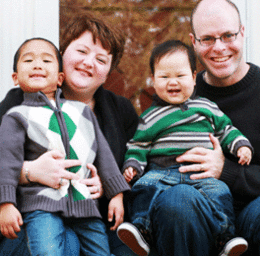
The process to adopt a child is a long, arduous one, leading many families to look overseas for quicker results. But will rising regulations make international adoption even more difficult?
As is the case with most adoptions, the story of how Rob and Karen Becker (pictured) came to be the parents of two young Korean boys is not cut and dry. It is filled with lots of love, devotion, time and tears. It spans back for years, far longer than their children will probably ever realize, at least for now anyway. The Beckers share everything with their children, and just like they are honest about where the boys were born and how they arrived in the United States, some day they will share just what they had to go through to be blessed with two boys of their own.
“The main, short answer, as to why we decided to adopt internationally was that I had had four pregnancies and five babies—one set was twins—but I lost all of them because they were ectopic pregnancies,” Karen Becker says. “After losing so many, we really just wanted a sure thing. We had looked into the different types of adoption that were available, and felt international was the surest thing. We really just wanted to have a child like everyone else.”
Becker says another reason she and her husband decided to adopt internationally was circumstantial. A good friend of the Cherry Hill couple had just adopted from the agency they decided to work with, and she offered advice and support when the couple needed it most. “Adoption isn’t the easiest, so if you have someone there who can support you, and show you what they did, it can be just a little more natural to follow their lead,” she says.
From the day their application to adopt was approved in December 2004 to the day they came home with their oldest son, Sam, in June 2005, it took the Beckers roughly seven months to go through the adoption process. Sam’s adoption was a special one, because he was considered a “waiting” child, meaning he had a health concern and would be placed in a home quicker than usual. But the adoption of their younger son, Max, four years later took 18 months to complete. While every case is different, they believe if they had decided to go the domestic adoption route back then, they would have had very different experiences. “There is a definite difference between private and foster adoptions, and I think we had heard more about private adoptions. Waiting to be chosen after we had lost so much was not something we were emotionally prepared to do,” Becker says.
According to the fiscal year 2012 Annual Report on Intercountry Adoption from the U.S. Department of State, 8,668 families adopted internationally last year. While that seems like a large number, international adoption numbers have been steadily declining. (In 2004, the peak year for international adoptions, 22,991 children were adopted from other countries.) All this on the heels of highly publicized international adoptions by celebrities like Madonna and Angelina Jolie. Even Phillies pitcher Cole Hamels and his wife Heidi adopted an Ethiopian baby late last year. Professionals close to the situation suggest those numbers are not due to lack of interest or orphans, but rather rising regulations, including longer approval times abroad.
“One of the reasons people went the international route was because the time was quicker,” says Susan Cox, vice president of policy and international affairs for Holt International, an agency specializing in international adoptions with offices across the country, including offices serving South Jersey residents in Trenton and Bensalem, Pa. Holt is the preeminent expert in international adoption, as its founders helped revolutionize the process in the United States back in the ’50s. “As times increase, domestic adoption becomes more appealing. … Internal adoption also requires families to travel, and in some cases it requires at least two trips, and a short period of time staying there. That can be a limiting factor for a lot of people with regard to work schedule and their families. Adoption has become complicated internationally.”
Other complications include countries’ increased reluctance to allow children to be adopted by American families. The Beckers, for example, could not adopt another Korean sibling for their boys because South Korea has changed its laws and they would not be eligible to adopt from the country again. Joe and Mary Damiri find themselves in a similar situation, as they adopted their two boys, Luke, 10, and William, 8, from Russia. In the final days of 2012, Russian President Vladimir Putin signed a bill banning Americans from adopting children from the country. Mary Damiri says she finds the bill heartbreaking. “My heart goes out to any child who is in need of a family,” the Mullica Hill resident says. “That’s a basic need of any child—to be loved by a parent or parents—and to cut that option off to the children, it’s so disappointing.”
Another factor that had affected international adoptions was a complicated one—the birth mother. Maxine Chalker, executive director of Cherry Hill’s Adoptions from the Heart, a private adoption agency, says many families decided to go the international route because they had a “fear that the birth parents would come and take their children away.”
“Well, I’ve been doing this for 20 years, and I’ve never heard of that happening,” she says. “I also believe it’s better for the children to know exactly where they come from in regard to medical concerns.” Chalker says her agency only places infants, and rarely has anyone wait more than two years for a child, a figure that is not nearly as high as most would expect. In fact, according to the U.S. Department of State, in 2012, average days to adoption completion for children from the Dominican Republic, at 741, and Mexico, at 770, were longer. Of course, a majority of the waits were much shorter; a factor that Damiri says weighed greatly into her decision to adopt 10 years ago, and would still affect her decision today.
“Would I do it differently? I don’t think so,” she says when asked if she would choose the international route again if she were to adopt another child. “I think when you walk into the idea of adoption, you can look at it from foster to adopt, private adoption and international, and we looked at everything. The first thing we liked was that we could follow along in my sister-in-law’s footsteps, because she had adopted from Russia before we did, and we liked the immediacy of it. We were told roughly nine to 12 months from the initial processes, we would be placed. Nine months to the date we first signed paperwork, we were home with Luke.
“I can’t honestly say what the time frame would have been for us if we had gone domestic then, because it was unspecified,” she continues. “For every other country, there was a set time frame. That’s what we needed to know.”
The fact of the matter is adoption can be a long and complicated experience, no matter which route you decide to take. In New Jersey, that process can seem even more complicated, as all families must go through an extensive licensing procedure in order to foster and/or adopt. “You’re going to go through a process,” says Mary Jane Awrachow, CEO of Foster and Adoptive Family Services of Monmouth Junction. FAFS processes all applications for adoption on behalf of the New Jersey Department of Children and Families. “You will go through a home study, they will check your financing, and they’re going to talk to your doctor and your neighbors.
They are going to put you through a licensing process so that you have a dual license for foster care and adoption. That process in and of itself can be difficult.” Each route a family may decide to take has its own complications—if they decide to foster to adopt, for example, they may not be able to adopt in the long run because the child’s family may not be willing to give up their rights to the child. Additionally, any adoption may take longer if the family is looking for a child with a specific characteristic, like age or race. As a result, Awrachow suggests seeking out advice and support from people familiar with the process. “There are so many resources in the area right now,” she says. “There are support groups. There are other people you can talk to who have done it.”
While it is a complicated process, the fact of the matter is, there are thousands of children waiting to be adopted around the world, and there are just as many families who desperately want to adopt them. “When we look back in retrospect, our lives, and we hope theirs, are better. Not because we took them out of Korea, but because we are a good family and give them whatever we can,” Becker says. “We honestly feel like we’re luckier than they are. We chose adoption. They didn’t.”
Published (and copyrighted) in South Jersey Magazine, Volume 10, Issue 8 (November, 2013).
For more info on South Jersey Magazine, click here.
To subscribe to South Jersey Magazine, click here.
To advertise in South Jersey Magazine, click here.












